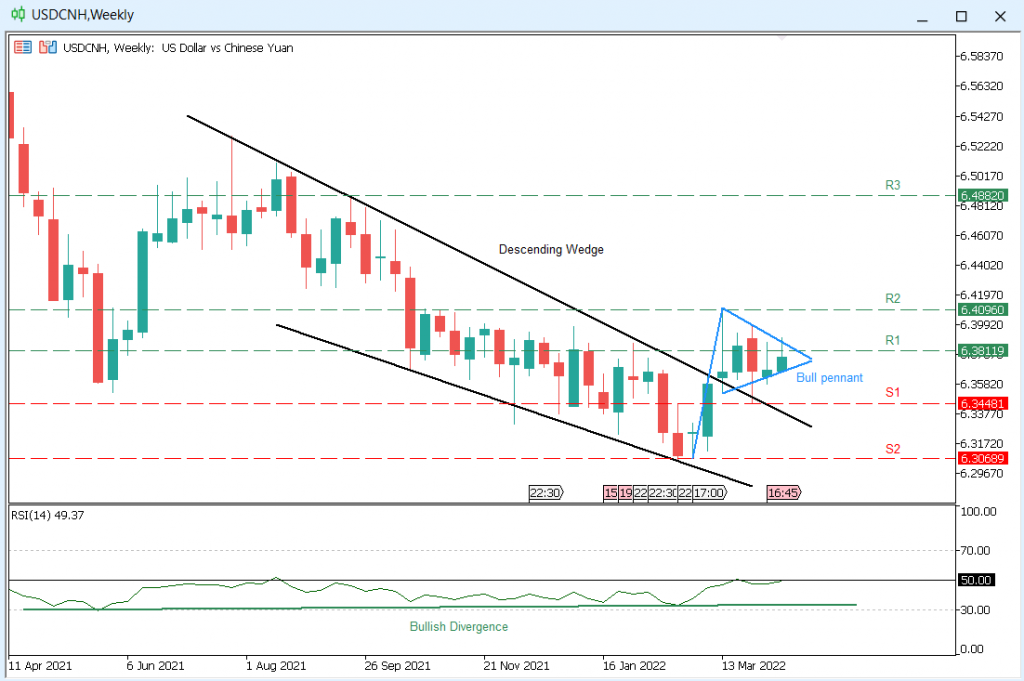
Since May 2020, the Chinese yuan has been one of the strongest performing currencies that had steadily appreciated against the US dollar. However, in recent weeks, USDCNH is showing some signs of strength after reversing from its lowest point since April 2018. The US dollar index (DXY) which gauges the greenback’s strength against a basket of rival currencies, is floating above 100, at the highest levels in nearly two years. The price movements of the USDCNH could be largely attributed to a few reasons which will be further elaborated below.
Hawkish Fed to tackle inflation
With the strong economic recovery and record low unemployment rate in the US, the Federal Reserve is under immense pressure to normalise its highly accommodative monetary policy which has driven inflation to the highest levels in 40 years. The ultra-loose monetary policy, which was aimed was to buoy the economy during the Covid-19 lockdown in 2020 is coming to an end as Fed officials are sounding more hawkish than ever. The Fed delivered its first rate hike of 0.25% in its March FOMC meeting and markets are anticipating a high likelihood that the Fed will step up its tightening measures by delivering two back to back 0.50% point rate hikes in the upcoming May and July meetings to tackle the inflation. A hawkish central bank generally brings about positive price impact on a nation’s currency.
Diverging monetary policies amid struggling Chinese economy
On the other hand, the economic situation in China is very different from the US as the nation is currently battling its worst Covid-19 outbreak ever. Prior to this wave of infection, which sent major cities like Shanghai to enter a strict lockdown, the Chinese economy was already struggling. The grim outlook of the Chinese economy has led markets to anticipate an earlier than expected monetary policy easing by the People’s Bank of China (PBOC). The increasingly diverging monetary policies between the American and Chinese central banks are narrowing the yield spread between the US dollar and Chinese yuan, favouring the former against the latter.
Technical Analysis
After the gradual descent in a falling wedge since July 2021, USDCNH broke out of the structure on 14th March and established a support above the upper band of the wedge after a successful retest on 1st of April. A breakout from a falling wedge is typically a bullish reversal pattern. Simultaneously, the currency pair is also showing another bullish chart pattern – a bull pennant. This can be identified when prices rise in a series of bullish candles, before consolidating in a symmetrical triangle which resembles a pennant. A bullish divergence on the Relative Strength Index (RSI) is another indication that prices may be headed for an uptrend.
Looking ahead, if the USDCNH breaks out from the bull pennant at around 6.3812 (R1), the resistance at 6.4096 (R2) must be broken to validate further upside to achieve technical target at 6.4882 (R3). In the alternate scenario where prices fail to sustain its rally and retraces, 6.3448 (S1) would provide support for the pair.
Key events to watch this week:
Tuesday, April 12
USD – Consumer Price Index ex Food & Energy (MoM)(YoY)(Mar)
Wednesday, April 13
USD – Fed’s Brainard speech, Monthly Budget Statement(Mar)
CNH – Exports (YoY)(Feb), Imports (YoY)(Feb), Trade Balance USD(Feb)
Thursday, April 14
USD – Initial Jobless Claims(Apr 8), Retail Sales (MoM)(Mar), Retail Sales Control Group(Mar), Retail Sales ex Autos (MoM)(Mar), Michigan Consumer Sentiment Index(Apr)
Trade Forex on Phillip MetaTrader 5 (MT5).
Trade Forex at zero commission on Phillip MetaTrader 5, a dynamic platform that offers low spreads. Integrated with Acuity’s Signal Centre and Trading Central Indicators, and available on mobile and desktop app, you will never miss a trading opportunity with Phillip MT5.
Download Trading Central’s Market Buzz for updates on more topics.
What’s more? Phillip MT5 is now supported on Mac OS! To install, simply download the file below and complete a simple installation process.






